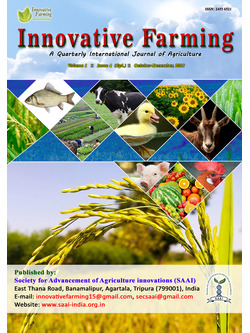
Efficacy of Some Plant Extracts against Epilachna Beetle (Henosepilachna vigintioctopunctata (F) (Coleoptera: Coccinellidae)
S.N. Das*
Agricultural Training Centre/ State Agricultural Management and Extension Training Institute, Ramakrishna Mission Ashrama, Narendrapur, Kolkata, West Bengal - 700 103, INDIA
Soumyesh Mandal
Agricultural Training Centre/ State Agricultural Management and Extension Training Institute, Ramakrishna Mission Ashrama, Narendrapur, Kolkata, West Bengal - 700 103, INDIA
M.L. Chatterjee
School of Crop Protection, College of PGS, Central Agricultural University, Meghalaya - 793103, INDIA
DOI: NIL
Keywords: Plant extracts, Toxicity, LC50, Epilachna beetle
Abstract
In a laboratory experiment, six plant products were evaluated for their toxicity to control the effect of adult epilachna beetle on brinjal. Among them, parashi showed lowest LC50 value (0.34109), followed by oleander (0.34610), ramtulshi (0.35135), neem (0.48600), marigold (0.73190) and custard apple (0.79220) after 120 hours of treatment. The order of relative toxicity was found in the following way: parashi > oleander > ramtulsi > neem > marigold > custard apple.
Downloads
not found
Reference
Abbott, W. S. 1925. A method of computing the effectiveness of an insecticide, Journal of Economic Entomology, 18: 265-267.
Bhargava, M. C. and H. M. Meena. 2000. Efficacy of some vegetable oils against pulse beetle, Callosobruchus chinensis (Linn) on cowpea [Vigna unguiculata (L.)] Entomocongress, 5-8 November, Trivandrum, Kerala, India, 49 pp.
Finney, D. J. 1971. Statistical methods on biological assay. Griffin, London. 668p
Ghosh, S. K. and G. Chakraborty. 2012. Integrated field management of Henosepilachna vigintioctopunctata (Fabr.) on potato using botanical and microbial pesticides. Journal of Biopesticides, 5 (supplementary): 151-154.
Mondal, S. and S. S. Ghatak. 2007. Bioefficacy of some indigenous plant extracts against epilachna beetle [Henosepilachna vigintioctopunctata, Fabr.] infesting cucumber. Proc. Natl. Sym. Plant Protection- Technology Interface, December 28-29, 2007; p. 107. Assoc. Adv. Plant Protection, Bidhan Chandra Krishi Viswavidyalaya, Nadia, West Bengal, India.
Prakash, A. and J. Rao. 1997. Botanical pesticides in agriculture. CRC Lewis Publs. Boca Raton, USA. 481 pp.
Saxena, R. and A. K. Shrama. 2005. Insecticidal potentialities of Agrratum conyzoides and Nerium indicum leaves extracts against Epilachna 28 punctata (F). Vegetos, 18(1-2): 43-45.
Swaminathan, R., S. Manjoo and T. Hussain. 2010. Anti-feedant activity of some biopesticides on Henosepilachna vigintioctopunctata (F.) (Coleoptera: Coccinellidae). Journal of Biopesticides, 3(1) Special Issue: 77 – 80.
Upasani, S. M., H. M. Kotkar, P. S. Mendki and V. L. Maheshwari. 2003. Partial characterization and insecticidal properties of Ricinus communis L. foliage flavonoids. Pest Management Science, 59(12): 1349-1354.
Wink, M. 1993. Production and application of phytochemicals from an agricultural perspective. In: Phytochemistry and agriculture, (Van Beek, T. A. and Breteler, H. eds.), vol. 34, Clarendon, Oxford, UK, 171-213 pp.
